Digging A Little Deeper Into Fight Club
We know that the protagonist (Cornelius/Tyler/Ed Norton) is slowly losing his mind due to … something. He has insomnia - but the cause is only lightly touched on. A few scenes are dedicated to graphically showing you why - rather than hitting you over the head with drippy dialog.
He’s a “Recall Coordinator” that flies around the country staring at death and destruction - and has to apply math to decide whether to perform a recall. His recounting of this is incredibly cold:
Take the number of vehicles in the field: A, multiplied by the probable rate of failure: B, then multiply the result by the average out of court settlement: C. A times B times C equals X - if X is less than the cost of a recall, then we don’t do one.
This hints at the kind of person Tyler is. What kind of person takes a job like the one he’s portraying? This isn’t my main point - but it’s important to understand that Tyler is a pressure-cooker that has two primary forces brewing inside of him: Animal rage and the need to destroy - not only himself but the world around him. This is fueled by the destruction he sees on a daily basis from his job.
Guilt, remorse, regret, fear and pain - this is fueled by the loss of life that is casually dealt with by his job
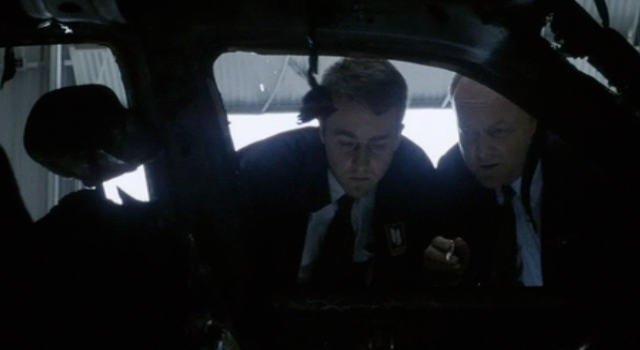
These psychological forces make a pretty tidy Yin-Yang. The two forces spinning in opposition that tear Tyler apart. He didn’t drift into psychosis - no one ever does - he was pulled apart at the seams and we watch as the two main players in his psyche do battle (and have sex in a perfectly ironic love/destruction battle).
The problem is - the movie makes it clear that Tyler (Brad Pitt) was only a part of Ed Norton’s imagination. Not so much for Marla. This is too single-sided, too convenient for a movie - a “Single Serving Plot” if you will. It’s a subtle bit of film trickery - that by not doing the full reveal we’re forced to take Marla home with us in our minds as a real being. A plot point.
But she’s not. She’s not “rounded” as a character. She has no reason to exist in the film other than to mirror Norton’s psychosis. In every scene she antagonizes him - either directly or through guilt/fear and pain. She IS his guilt, fear and pain… and she shows herself when he tries to contain the forces inside of him by going to groups as a form of therapy…
Enter Marla
Fight club is heavy on symbolism - and Marla’s entrance is no exception. This is our first glimpse of her:
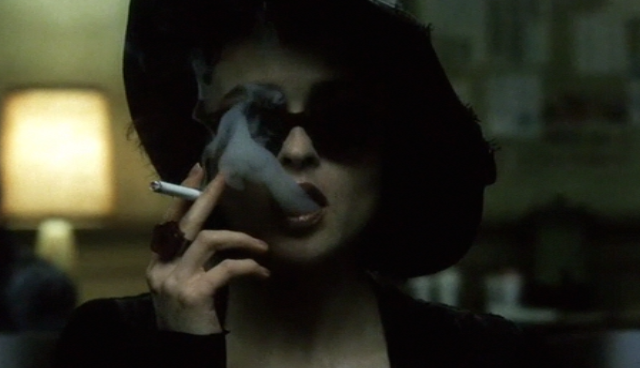
That’s a perfect opening line for Marla. It’s not a question - it’s a statement, about herself. Tyler immediately recognizes her, and hates her almost immediately:
Marla… the Big Tourist. Her lie reflected my lie.. and suddenly, I felt nothing… I couldn’t cry. So once again, I couldn’t sleep.
She is his remorse. His guilt. His lies - not only from posing in these Sickness Circles, but also the lie that is his life (IKEA catalog scene, his job - his whole life is a massive lie). He felt relief from his guilt and remorse for a bit, but his psyche mounted a counter-attack, in the form of Marla Singer.
You’re probably thinking this is “plausible - but no way because later in the movie…”. I’m getting there. I have to build the case just a bit more.
Directorial Casting
A good director will straddle the line between giving it up entirely, and making your subconscience work. Symbolism is a direct pipe into your brain, and a really good director won’t tell you AT ALL what it is they want you to react to, see, or feel. Fincher (Director of Fight Club) is a director that completely understands this.
He’s also a bit playful. He comes right out it with it as a subplot of the movie: Tyler has a job in the theater where he splices images into films. In a way, Fincher is casting himself in the movie in a meta-tangential way. In many scenes you see Tyler spliced right in - like this one right after he sees Marla for the first time. He’s staring after her, wondering who she is and why she’s there:
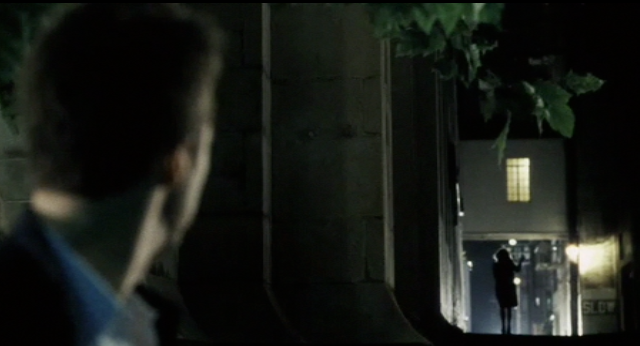
And then BAM - guess who shows up:
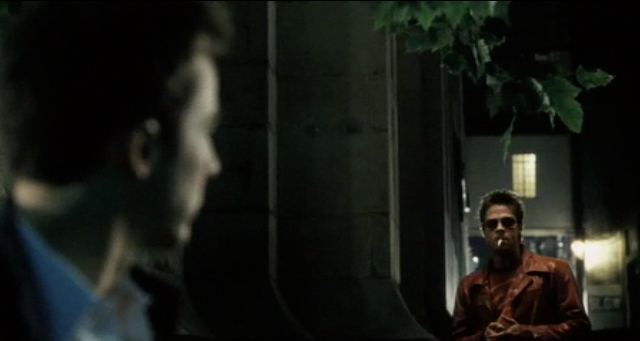
The fact that Fincher splices Tyler in all over the beginning of the movie is telling you, in your face, I’m messing with you - inserting himself quite literally as part of the cast:
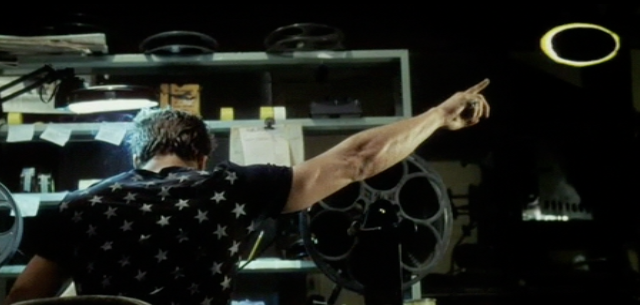
The fact that the “Big Reveal” isn’t given (that Marla wasn’t real) should not dissuade you from contemplating it. The film is about the subtle loss of a grip on reality through the use of imagery and self-deception.
Some Not-So-Subtle Hints
Consider the dialog when Tyler (Norton) confronts Marla and the ensuing scenes:
Marla: I saw you practicing this Tyler: Practicing what? Telling me off… is it going as well as you hoped?
It’s a challenge. You can’t get rid of me that easy dude - I’m your pain, your power, your remorse. Don’t think you can get rid of me by going to some groups and trying to get some sleep. Not that easy.
Something else to notice is Marla’s demeanor and wardrobe. She’s cool, confident, sexxy and strong. She’s in control - she owns Tyler completely and he’s absolutely afraid of her as witnessed by the scene above. She confronts him and he unravels - and get’s a bit sensitive… which is another “tell” in the way the conversation is carried out:
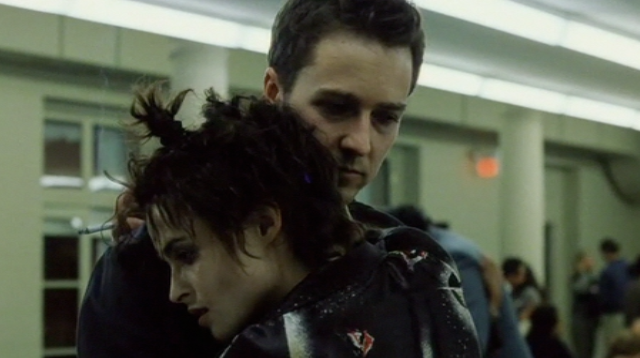
Tyler: when people think you’re dying man they really really listen to you… instead of just - Marla: instead of just waiting for their turn to speak?
This is a sensitive moment - probably the most emotionally honest moment of the film for Tyler. He doesn’t feel heard, he doesn’t have a voice, he can’t stand up for himself (which, ironically, is what’s happening here with Marla). The twist of her finishing that sentence for him is delicious - and get this - while they are entwined as a single being.
In the ensuing scene - where Tyler insists that she go elsewhere - they begin to negotiate. I could go off on the 5 stages of grief and how this fits it… but let’s stay on track. Marla charges into a laundry and steals some clothes, then barges into the street without looking (a death wish). Many will point to this scene and say “AHA! Your theory SUCKS!”
But notice how the scene plays out (which is repeated later in the movie) - and Tyler’s reaction:
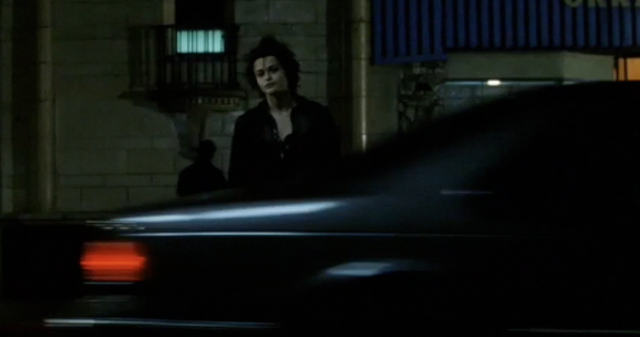
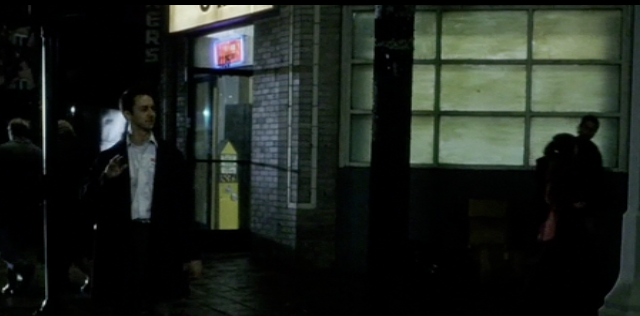
The scene moves in a bit of a disorienting blur, following a car, over to Tyler who’s waiting on the corner. The car honks loudly - as if at HIM, and he waves as if to say “sorry”. How could this be if he’s on the sidewalk?
The answer is the same as watching Pitt’s Tyler talk to the crowd during the fights - he’s watching himself as another persona. This gets amplified in the following scene, where Marla charges into traffic YET AGAIN - but this time, apparently emboldened, Tyler stays put.
And the cars don’t honk. Don’t care that she’s there. Which is because she is not…
It’s tempting to nit-pick this, but why else would there be a juxtaposition of the exact same scene.
The Change Over
As the movie progresses Marla becomes more and more washed out. The initial scenes of her are all in the dark, amplifying and enforcing the darkness and remorse that she represents. She looks best here - her clothes are clean and black, she blends in, she’s the darkness of Tyler’s mind.
Tyler describes Marla in almost these exact terms:
Marla: the little scratch on the roof of your mouth that would heal if only you could stop tonguing it, but you can’t.
Self-induced pain and irritation that he can’t stop … tonguing. He’s using this pain - flexxing it, tonguing it greedily because it’s also creating Tyler (Pitt). In contrast to the idea that Pitt is the result of Norton’s slide into insanity - he’s not. He’s a defense mechanism.
When Pitt comes in he’s all about reacting to “what you’re told to be and do”. He reflects on parental betrayal and that you’re “not a unique snowflake” etc (which we’re all familiar with). He’s trying to toughen up the Sad Tyler - to make him fight his own mental crap in order to get ahold of himself. To hit rock bottom, give up and accept that “God doesn’t like him” (which brings us back to the 5 stages of grief… the last being acceptance).
Tyler is trying to heal himself with his animal ego.
The ensuing interactions between Pitt, Norton, and Marla are awash in psychological overtones. Sex between the alter egos igniting a Freudian freak show of pain, sex, and self-torture. This is made a bit Greek when Norton states how his parents used to pull the same disappearing act when he was a child.
Two parts of the whole - mother and father, female and male, and all the things that they represent… fighting for dominance in the main character.
As the fight for dominance continues, it’s clear that Marla (remorse and guilt) is losing. Her scenes are dwindling, and in each she begins to look paler and act more and more defeated, culminating in this scene in the kitchen:
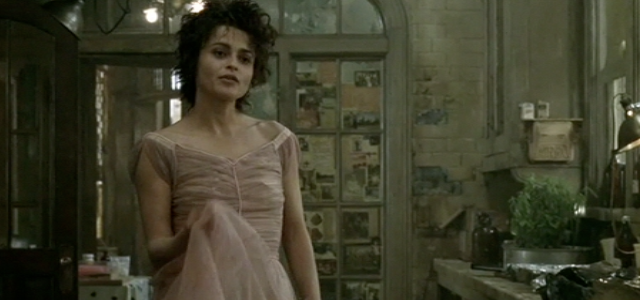
This scene ends with Marla being pushed out of the house (the house, of course, is a symbol for Tyler’s psyche). We don’t see Marla much as the movie transitions into “guy stuff”. No more support groups, no more introspection - just blood and punches.
Marla, Defeated
The next meaningful scene from Marla comes when Norton awakes from what seems to be a long, long nap and is wandering around his house, wondering what has happened (it’s Project Mayhem). He intones:
I’m all alone. My father dumped me, Tyler dumped me, I am Jack’s Broken Heart…
Self-pity, self-loathing… pain and guilt. Identifying Tyler (Pitt) with his father and essentially lapsing back into his pathetic state at the beginning of the film:
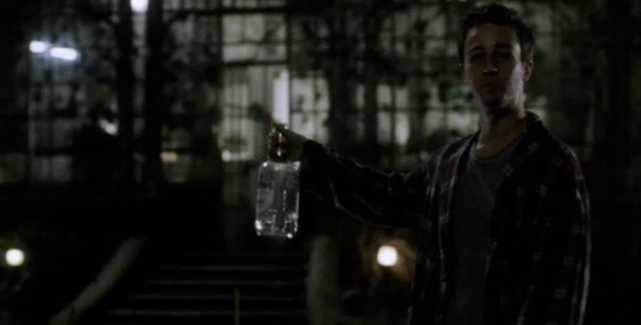
And who should appear right then? Yep - Marla. Looking black again… and it’s night time. She’s literally in her element… and she strikes:
Marla: Can I come in? Tyler: He’s not here… Marla: Wh…what?
TYLER. ISN’T. HERE. Tyler went away. Tyler’s GONE.
What many people don’t realize about this scene is that Tyler has “flipped” into Pitt’s character right here. His defenses are pricked up because Marla is trying to attack while Sad Tyler is vulnerable. Enter Animal Tyler - flatly stating that she can’t come into the house (Tyler’s brain) because Tyler is gone (he’s MINE). You lose.
One of the great things about this movie is the acting. Helena Bonham Carter just nails this defeated look:
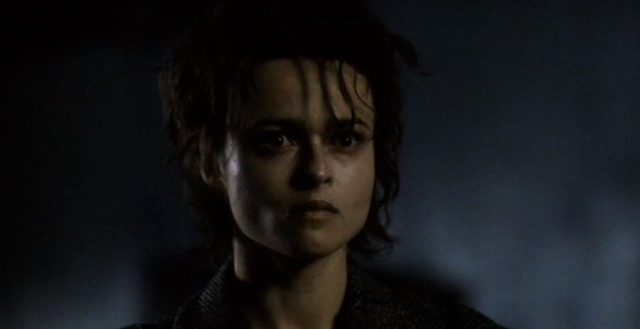
It’s easy to look at this and say “that’s rejection - not defeat” and write her off as the “girl, hurt”. But look again. You can see the rage - the powerlessness. The fact that it takes place outside of Tyler’s house is perfectly executed.
Marla’s Denouement
The main thrust of Marla’s character (whether you believe she exists or not) is to balance and counter the animal that is Pitt’s character. This is seen rather directly when Tyler realizes that he’s been seeing things - and that Pitt’s character is completely made up.
He feels fooled and deceived - by himself no less - so he does what anyone would do. Call mom (or in this case, what mom represents in a Greek way). Re-enter Marla. It’s Marla that confirms that Tyler doesn’t exist - while chastising and punishing Norton for giving into him.
What happens next is a scene that many people point to as proof that Marla did in fact exist: the restaurant scene. In that scene, the waiter suggests some food for her, after Norton states that he wants it “clean”:
In that case sir may I advise against the lady eating the clam chowder…
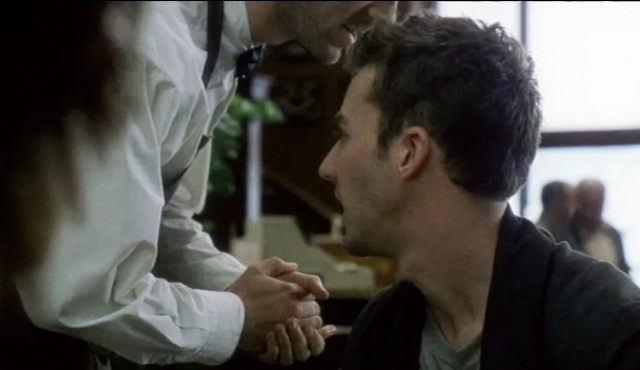
In this scene you can see the waiter acknowledge Marla’s order, and then recommend something different for her. So she exists, right?
Wrong. Tyler’s minions know he’s insane - that’s made clear throughout the movie with quips like “he only sleeps 2 hours and a night” and “he was born and raised in an insane asylum”. They’ve been prepped by Pitt’s character as to what to say when Norton tells them to stop Project Mayhem.
They know he’s nuts, and they compensate for it.
The waiter doesn’t speak to Marla - he can’t, that would be crazy of HIM. He simply pretends she’s there because Tyler is
sitting right in front of him.
Tyler is a rock star, a demi-god, and he better not screw up. So he goes along with Tyler’s insanity - the telling part of the scene being where he talks directly to Tyler, whispering his suggestion for Marla. She’s not there. He knows it - so he plays along as well as he can, which is actually rather clumsy.
Another scene that people will often refer to is the final scene - where Tyler looks out the window and sees his henchmen dragging Marla out of a bus. They’ve been told to find her, apparently, as she can undo the whole thing.
What happens in this final scene is incredibly debatable. In fact you could argue that none of it even existed at all - a grand illusion from the very definition of Salinger’s Unreliable Narrator. The books suggests he’s been committed already and we’re simply seeing one very grand psychotic break. I think it might be a little bit more than that, and something possibly a bit more fun.
Henchmen? Dude in a tower who has the fair maiden brought to him as he watches his destructive hand take down civilization around him? The fact that we even believe this scene is a joke - mostly on us.
As you watch it play out, ludicrous things happen one after the other. Norton blows a hole in his neck - apparently “killing” Tyler. He should be dead - but he’s not.
The henchmen come in and leave. “I’ll meet you guys downstairs” - really? They just set charges all over town in these massive buildings, why are they leaving? They’ve brought beer and chips for a party - one of them asking “where is everybody” as they get out of the elevator.
Walls of Jericho
That’s the name of the final scene in the movie - which is a very interesting title. The phrase, which most people have heard, is from the Bible and refers to the walls erected around the town of Jericho in the land of Canaan. Long story short - the Israelites needed a home, and Joshua decided it would be Jericho.
In the Bible, God spoke to Joshua and gave him a rather extraordinary plan: surround the city with your soldiers at the call of a ram’s horn - do this for 6 days (blowing horns around the town). On the 7th day - blow the horns again but this time, everyone shout at the same time as well, and the walls will crumble.
Joshua was a bit conflicted by this - does he trust God with this weird plan, or does he trust himself? He’s a pretty good military leader - and he’ll lose his command if God’s plan doesn’t work out. So he decides to stick with God and boom - and the walls came down.
This is one interesting scene. The dialog is plastic and 2-dimensional and Norton’s character is neither pathetic - nor is he seemingly real. The whole thing is just… not realistic at all.
Norton stands there, with Marla, and watches as the buildings fall. A plan that he had no part in - it was carried out by an unseen force… a twisted Divine Plan if you will.
Both Marla and Tyler seem completely out of character here. Marla is unsure of everything - Tyler’s dialog is cliche and trite. It’s as if the ending is sort of being “made up” out of thin air - as if there is no ending - like we’re being messed with.
And indeed we are:

Most people will remember the shot of a big … male organ right at the end as the film skips around. I wanted to keep this somewhat safe for work … so I didn’t put here.
Fincher. What we’re seeing is BS. A tidy ending that is utterly orthogonal to the story and reality. It’s fantasy - all of it. The fact that Marla is in it is no more a justification of her existence than is the reality of the buildings falling.
OK - I have to get back to work now.
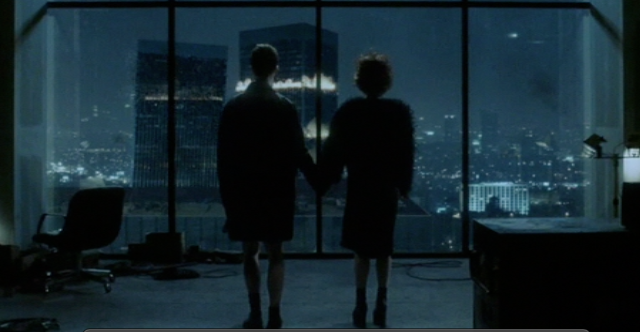
Update 2015
So many people have sent emails about this and pinged me on Twitter, some nice, some not so nice. They all point to literal circumstances in the film - where person X saw Tyler talking to Marla so therefore she must exist.
While interesting, it doesn’t really matter. The group of bar patrons walked up on Tyler and Pitt beating the crap out of each other in the parking lot (“hey fellas…”) - only later did you realize he was hitting himself.
The difference with Marla is that you’re not told explicitly like you are with Pitt. So, if your “evidence” is that someone looked at her, or reacted to her presence… well I spose I’d say see the rest of the film where people react to Pitt as well.
Ultimately: this is one person’s massive psychotic break and none of it is real so this debate is really academic. In fact as I was watching it recently I noticed something incredibly telling.
The scene where he sits with the doctor asking for help so he can sleep. He begs the doctor for some pills. Watch the scene again and focus on Tyler’s twitching hand, and see the doctor noticing it.
Tyler isn’t just suffering from insomnia, he’s also having withdrawals. He’s trying to kick, and he’s losing his mind… and we get to go along for the ride…
What a fun movie!